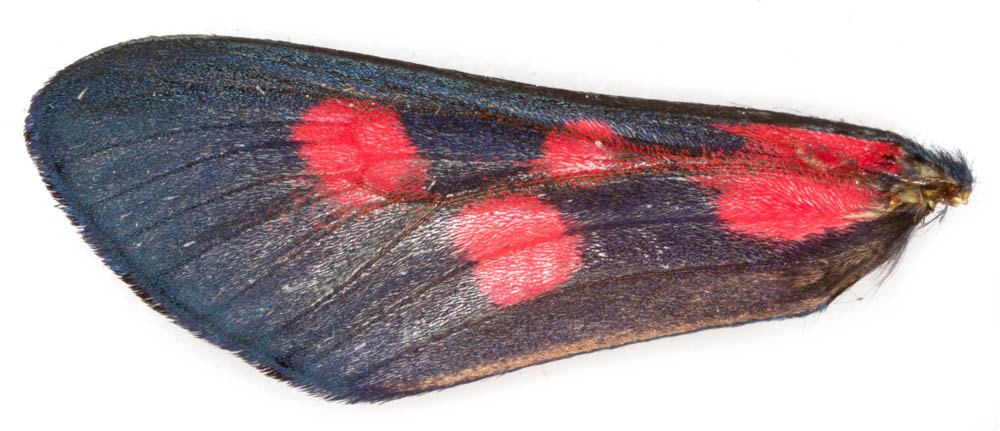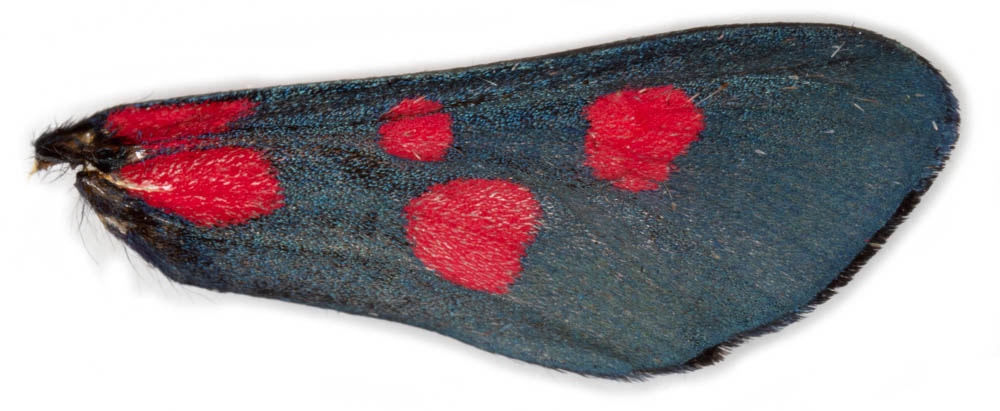54.009 Zygaena lonicerae (Narrow-bordered Five-spot Burnet)
|
ws: 22-40mm, fw: 15-19mm;
subspecies latomarginata: late Jun - Jul; meadow vetchling (Lathyrus pratensis), red clover (Trifolium pratense); common over much of England, but probably absent from SW.England subspecies jocelynae: late Jun-Jul; RDB - steep coastal grassy slopes on Skye ID: Almost indistinguishable from Z.ltrifolii (Five-spot Burnet). The following features may help: Location: Z.lonicerae is widespread over England and Wales(?); Z.trifolii has a much more restricted distribution in SW.England, the North and South Downs from Hampshire to Kent and parts of Wilsthire, Gloucestershire and Wales . Merging of spots 3+4: frequent in Z.trifolii, rare in Z.lonicerae Flight: Z.trifolii ssp palustrella flies earlier than Z.lonicerae, but there is overlap at the end of its flight. The following three features are also given in MBGBI2: 1. Forewing length:breadth - relatively short in Z.trifolii Drawings of Z.trifolii in MBGBI2, Waring and images of live moths from various websites have fw ratios ranging from 2.7-3.0; for Z.lonicerae the range is 2.6-2.8 (with 2 outliers of 2.5 and 3.0) - so this feature cannot be used to separate the species. 2. Forewing and hindwing more rounded at apex in Z.trifolii: whilst this may be apparent in comparing some images of the 2 species it does not seem to provide a reliable distinction. 3. Dark border of hindwing usually broader in Z.trifolii. It is probably true that the border averages broader in Z.trifolii (hence 'Narrow-bordered' for Z.lonicerae) but this is of little help in identifying an individual. There do not seem to be any genital differences between these 2 species. |
The only really reliable way of identifying Z.lonicerae as an adult seems to be to grow it from a positively identified larva. The larva of Z.lonicerae has very long hairs (setae) and this should provide a ready distinction from the short-haired larva of Z.trifolii.
A specimen found away from one of the known areas for Z.trifolii should be Z.lonicerae,
A specimen found in Cornwall or Devon is probably Z.trifolii
A specimen found on Skye is Z.lonicerae jocelynae
A specimen with spots 3+4 merged is much more likely to be Z.trifolii.
A specimen found on the North or South Downs in May or the first half of June is very likely to be Z.trifolii
There do not seem to be any reliable features that will definitively identify Z.trifolii/lonicerae with unmerged spots found at a known location for Z.trifolii away from SW.England in late June or July.
The identity of specimen §1 is based on it having been found in an area not known to have Z.trifolii. However, I have found larvae that appear to be short-haired on Foulness so the identity of the Foulness specimens is not yet clear.
A specimen found away from one of the known areas for Z.trifolii should be Z.lonicerae,
A specimen found in Cornwall or Devon is probably Z.trifolii
A specimen found on Skye is Z.lonicerae jocelynae
A specimen with spots 3+4 merged is much more likely to be Z.trifolii.
A specimen found on the North or South Downs in May or the first half of June is very likely to be Z.trifolii
There do not seem to be any reliable features that will definitively identify Z.trifolii/lonicerae with unmerged spots found at a known location for Z.trifolii away from SW.England in late June or July.
The identity of specimen §1 is based on it having been found in an area not known to have Z.trifolii. However, I have found larvae that appear to be short-haired on Foulness so the identity of the Foulness specimens is not yet clear.
§1 Foulness, Essex; 21/06/2009
§2 Bampton Grange, Cumbria; 25/06/2023; male; fw 16.5mm
All images © Chris Lewis
§2 Bampton Grange, Cumbria; 25/06/2023; male; fw 16.5mm
All images © Chris Lewis
Page published 17/04/2012 (§1) | §2 added 29/09/2023















